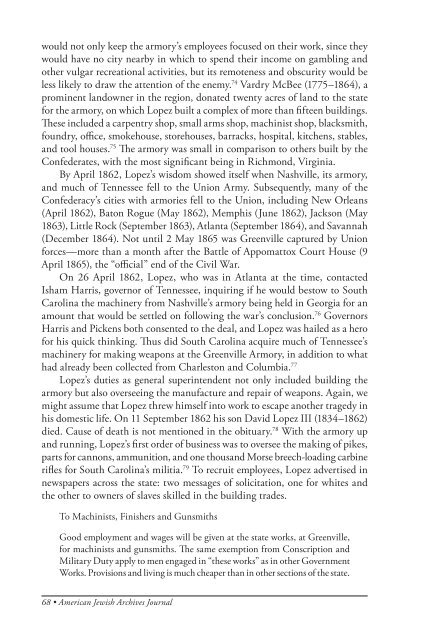American Jewish Archives Journal, Volume 64, Numbers 1 & 2
American Jewish Archives Journal, Volume 64, Numbers 1 & 2
American Jewish Archives Journal, Volume 64, Numbers 1 & 2
You also want an ePaper? Increase the reach of your titles
YUMPU automatically turns print PDFs into web optimized ePapers that Google loves.
would not only keep the armory’s employees focused on their work, since they<br />
would have no city nearby in which to spend their income on gambling and<br />
other vulgar recreational activities, but its remoteness and obscurity would be<br />
less likely to draw the attention of the enemy. 74 Vardry McBee (1775–18<strong>64</strong>), a<br />
prominent landowner in the region, donated twenty acres of land to the state<br />
for the armory, on which Lopez built a complex of more than fifteen buildings.<br />
These included a carpentry shop, small arms shop, machinist shop, blacksmith,<br />
foundry, office, smokehouse, storehouses, barracks, hospital, kitchens, stables,<br />
and tool houses. 75 The armory was small in comparison to others built by the<br />
Confederates, with the most significant being in Richmond, Virginia.<br />
By April 1862, Lopez’s wisdom showed itself when Nashville, its armory,<br />
and much of Tennessee fell to the Union Army. Subsequently, many of the<br />
Confederacy’s cities with armories fell to the Union, including New Orleans<br />
(April 1862), Baton Rogue (May 1862), Memphis (June 1862), Jackson (May<br />
1863), Little Rock (September 1863), Atlanta (September 18<strong>64</strong>), and Savannah<br />
(December 18<strong>64</strong>). Not until 2 May 1865 was Greenville captured by Union<br />
forces—more than a month after the Battle of Appomattox Court House (9<br />
April 1865), the “official” end of the Civil War.<br />
On 26 April 1862, Lopez, who was in Atlanta at the time, contacted<br />
Isham Harris, governor of Tennessee, inquiring if he would bestow to South<br />
Carolina the machinery from Nashville’s armory being held in Georgia for an<br />
amount that would be settled on following the war’s conclusion. 76 Governors<br />
Harris and Pickens both consented to the deal, and Lopez was hailed as a hero<br />
for his quick thinking. Thus did South Carolina acquire much of Tennessee’s<br />
machinery for making weapons at the Greenville Armory, in addition to what<br />
had already been collected from Charleston and Columbia. 77<br />
Lopez’s duties as general superintendent not only included building the<br />
armory but also overseeing the manufacture and repair of weapons. Again, we<br />
might assume that Lopez threw himself into work to escape another tragedy in<br />
his domestic life. On 11 September 1862 his son David Lopez III (1834–1862)<br />
died. Cause of death is not mentioned in the obituary. 78 With the armory up<br />
and running, Lopez’s first order of business was to oversee the making of pikes,<br />
parts for cannons, ammunition, and one thousand Morse breech-loading carbine<br />
rifles for South Carolina’s militia. 79 To recruit employees, Lopez advertised in<br />
newspapers across the state: two messages of solicitation, one for whites and<br />
the other to owners of slaves skilled in the building trades.<br />
To Machinists, Finishers and Gunsmiths<br />
Good employment and wages will be given at the state works, at Greenville,<br />
for machinists and gunsmiths. The same exemption from Conscription and<br />
Military Duty apply to men engaged in “these works” as in other Government<br />
Works. Provisions and living is much cheaper than in other sections of the state.<br />
68 • <strong>American</strong> <strong>Jewish</strong> <strong>Archives</strong> <strong>Journal</strong>
















